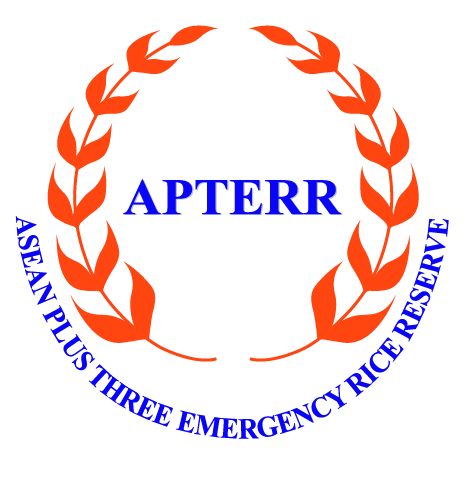![]() ASEAN Plus Three Emergency Rice Reserve
ASEAN Plus Three Emergency Rice Reserve
![]() ASEAN Plus Three Emergency Rice Reserve
ASEAN Plus Three Emergency Rice Reserve


The ASEAN Plus Three Emergency Rice Reserve (APTERR) is a regional cooperation established under the APTERR Agreement signed by the Ministers of the Agriculture and Forestry of the ASEAN Plus Three at the 11th Meeting of the ASEAN Minister on Agriculture and Forestry Plus Three (AMAF+3) on 7 October 2011 in Jakarta, Indonesia. The APTERR was officially established itself as a permanent mechanism and also marked the official launch of the APTERR Secretariat office in Bangkok in 2013.
We are keen to strengthen food security, poverty alleviation, and malnourishment eradication among its members without distorting normal trade, while the common goal of the APTERR Parties is the assurance of food security in the ASEAN+3 region.













400 MT
300 MT
3,000 MT
Total :3,700 MT
500 MT
3,000 MT
Total :3,500 MT
322 MT
4,000 MT
Total :4,322 MT
Natural Disasters

WEEKLY UPDATE ON NATURAL DISASTERS
IN ASEAN PLUS THREE
No. 439 ![]()
15 – 21 October 2025
Flash floods and landslides in Lao PDR were anticipated ahead of Tropical Storm Fengshen. According to the Department of Meteorology and Hydrology under the Ministry of Agriculture and Environment, Lao PDR on 20 October 2025, Tropical Storm Fengshen was expected to bring light to moderate thunderstorms across the country, along with heavy to very heavy rainfall and strong winds from 23 to 24 October 2025. Residents were urged to remain cautious due to the potential risk of flash floods and landslides caused by widespread heavy rain.
Source: Xinhua. (2025, Oct 20). Laos on alert for tropical storm Fengshen.
Indonesia faced volcanic eruption and earthquake within two consecutive days. Mount Lewotobi Laki-laki, located in East Nusa Tenggara province, Indonesia, erupted twice on 15 October 2025, spewing ash up to 10 kilometers high during the first eruption, and up to 8 kilometers during the second. The alert was raised to the highest level. Residents near the volcano were evacuated due to concerns about potential volcanic mudflows if heavy rain occurred. The following day, on 16 October 2025, a 6.7-magnitude earthquake struck Papua province in Indonesia. However, no tsunami warning was issued.
Source: Bangkok Post. (2025, Oct 15). Indonesian Volcano Lewotobi Laki-laki erupts again; Reuters. (2025, Oct 16). Earthquake of magnitude 6.7 strikes Papua, Indonesia, USGS says.
Tropical Storm Fengshen claimed seven lives in the Philippines. Tropical Storm Fengshen hit the northern and central regions of the Philippines on 19 October 2025, triggering flooding in the Central Luzon, Mimaropa, Western Visayas, and Eastern Visayas regions. The storm killed seven people, injured one, and left two missing. A total of 133,196 individuals across nine provinces and 35 cities and municipalities were affected. At least 13,710 people were displaced. Key infrastructure, including 12 road sections, 10 bridge sections, and 60 seaports, was disrupted.
Source: VietnamPlus. (2025, Oct 20). Storm Fengshen batters Philippines, Laos issues rainfall warning.
Typhoon Fengshen threatened flash floods in Viet Nam. On 20 October 2025, the National Centre for Hydro-Meteorological Forecasting of Viet Nam warned that combined effects of Tropical Storm Fengshen’s circulation, cold air, easterly wind disturbances, and orographic enhancement could bring widespread and prolonged heavy rainfall from 22 to 27 October 2025 across Ha Tinh to Quang Ngai provinces. Mountainous areas faced high risks of flash floods and landslides, while flooding was anticipated in low-lying and urban zones. Local authorities were advised to ensure the safe operation of hydropower and irrigation reservoirs and prepare for water levels in rivers from Quang Tri to Quang Ngai possibly exceeding the highest alert level. The disaster risk level due to flooding and inundation was rated at level 3 out of 5.
Source: VOV. (2025, Oct 20). Typhoon Fengshen changes course, threatens central Vietnam with flooding.
Typhoon Fengshen wreaked havoc in China’s Hainan province. On 20 October 2025, typhoon Fengshen suspended operations at three main ports, including Xinhai Port, Xiuying Port, and Railway South Port, in Haikou, the capital of Hainan province, China with operations anticipated to resume around 23 October 2025 depending on the weather. Some train services to and from Hainan Island were also cancelled, and emergency response measures were upgraded to improve readiness. Meanwhile, authorities in Guangdong province activated a typhoon emergency response on 20 October 2025. All maritime activities, including fishing and tourism, were suspended.
Source: Anadolu Agency. (2025, Oct 20). South China’s 3 ports suspend operations in face of Typhoon Fengshen.
Rice Situation

WEEKLY UPDATE ON ASEAN PLUS THREE
RICE SITUATIONS
No. 439 ![]()
15 – 21 October 2025
The Rice Department discusses measures to prevent a fall in paddy price. The Rice Department has invited representatives from relevant government agencies and the private sector to discuss measures to prevent a decline in paddy rice prices during the 2025/26 harvest season and to maintain stable rice prices. According to the Rice Department, farmers across Thailand are expected to begin harvesting their crops from October to November 2025. Most rice fields have produced good yields this year, with minimal damage from natural disasters. As a result, the release of large quantities of paddy rice onto the market could depress paddy rice prices.
Source: Nation Thailand. (2025, October 19). Rice Department to discuss measures to prevent fall in paddy prices for new harvest.
Japanese rice farmers plan to expand their rice field areas. According to the Ministry of Agriculture, Forestry and Fisheries (MAFF) survey showed that on Friday, 29 percent of Japanese rice farmers plan to expand their planting area for the 2026 harvest. Japan’s rice prices stay near record highs following a surge in 2024, despite government stockpile releases to control rice prices. Meanwhile, the online survey of 8,095 farmers, conducted by the MAFF from June to August, found that about 56 percent of rice farmers will maintain current acreage in 2026. Regarding production plans for the next five years, 11 percent expect to reduce or stop production, mainly due to a lack of successors.
Source: Japan Today. (2025, October 18). 29% of Japan's rice farms to raise crop acreage amid price surge: survey.
The Ministry of Agriculture, Forestry, and Fisheries (MAFF) is considering a review of the appropriate level for the government's rice stockpiling. Due to the domestic rice demand having fallen 20 percent since 2001, set at about 1 million tons, when the current stockpiling level, MAFF plans to discuss the potential reduction of the government rice stockpile and expedite rice release for emergency response by subsidizing private storage costs. As part of a major review of paddy field policy scheduled for fiscal 2027, the stockpiling system is expected to be adjusted based on supply and demand, with specific volumes to be determined later.
Source: nippon.com. (2025, October 20). Japan Mulls Review of Rice Stockpiling Level.
Autumn rain delays rice harvest in the Republic of Korea (ROK). Due to unseasonal autumn rains in the ROK have disrupted the rice harvest has been disrupted, delaying new-crop shipments and worsening rice shortage. According to the Korea Agro-Fisheries & Food Trade Corporation (aT), as of 15th October 2025, the retail prices of rice were 67,351 KRW (46.86 USD) per 20 kilogrammes, up 27 percent from the same period in 2024, which was 52,980 KRW (36.86 USD).
*1 USD = 1437.30 KRW
Source: Chosun Biz. (2025, October 17). Autumn rain delays South Korea rice harvest and pushes fresh food prices up.
Copyright © 2023 apterr.org All Rights Reserved.